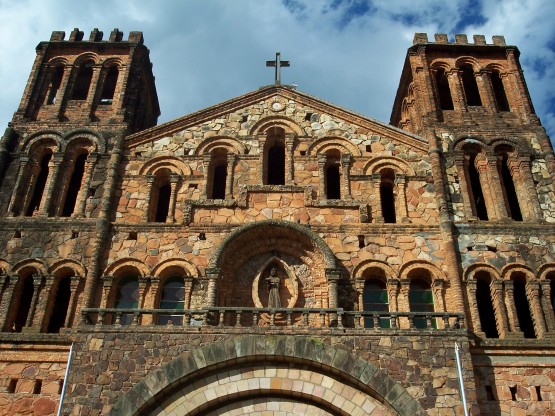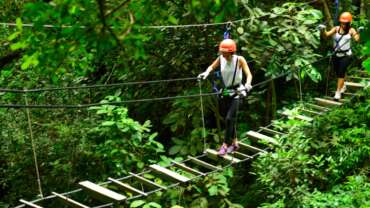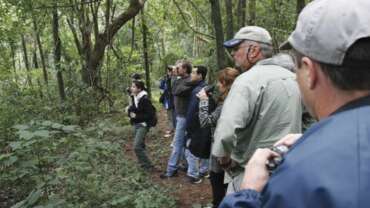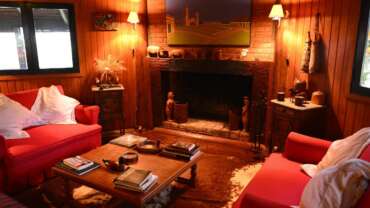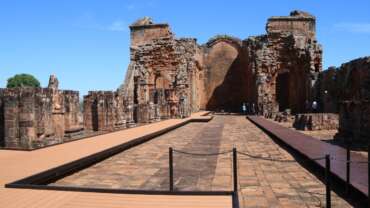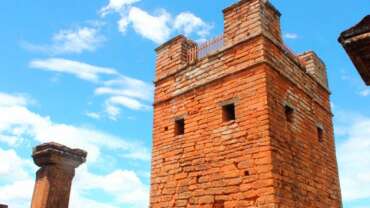Regions of Paraguay
Outskirts of Asuncion
Cordillera
The Altos mountain range is the imposing and breathtaking natural complex that represents the Department of Cordillera. The charming landscapes and various water streams make it one of the most beautiful areas in Paraguay and a thoroughly enjoyable place in which to spend the summer.
It is located in the central west of the Eastern Region. Its capital and most populated city is Caacupé, an area known as Paraguay’s “Spiritual Capital” due to the presence of the Basilica of the Virgin of Caacupé. The Church gathers more than a million and a half faithful pilgrims every year on December 7 and 8.
Other cities in Cordillera are: Altos, Arroyos y Esteros, Atyrá, Caraguatay, Emboscada, Eusebio Ayala, Isla Pucú, Itacurubí, Juan de Mena, Loma Grande, Mbocayaty del Yhaguy, Nueva Colombia, Piribebuy, Primero de Marzo, San Bernardino, San José Obrero, Santa Elena, Tobatí and Valenzuela.
Lake Ypacaraí is the main attraction catching the attention of tourists in San Bernardino, the country’s primary summer resort. In Caacupé and Piribebuy, the water streams Ytú and Yhaguy Guazú, the Amambay Falls, Piraretá and Siete Caídas are stunning natural wonders.
Other tourist attractions are the Hassler Museum in San Bernardino; the exact place where the battle of Acosta Ñu was waged in Eusebio Ayala; and the Basilica of Caacupé and churches in Altos, Piribebuy, Valenzuela and Atyrá, all of which still preserve their original Franciscan altarpieces.
In Caraguatay you can visit Vapor Cué, the place where the Paraguayan naval force was abandoned to prevent the ships falling into enemy hands during the Triple Alliance War.
Additionally, you can find all kinds of handicrafts in the area. These can be the the traditional garments called “ponchos de setenta listas”, items made of the weaving technique known as “encaje ju” or embossed in leather, wood carvings, and many others.
Paraguarí
The ninth Paraguayan Department, Paraguarí, offers the most varied tourist destinations, each and every one of them rich in history and natural beauty. It is surrounded by the Departments of Cordillera, Caaguazú, Misiones, Caazapá, Guairá, Ñeembucú and the Central Department.
The mountain range that outlines the area makes of Paraguarí a beautiful scenery with imposing natural landscapes, the Mbatovi Eco-Reserve stands out as one of the most important ecological tourism destinations. The vast park allows for the practicing of extreme sports such as rappel, zipline, canopying and trekking, while also offering a majestic view of the mountain range and Mbatoví hill.
The passing of time has left interesting historical marks on the walls and murals of the old railway stations in the cities of Ybytymí, Escobar, Pirayú and Tebicuary-mi, although one can also choose to enjoy the already restored ones in Paraguarí, Caballero and Sapucai. This last town is also home to the fully restored railway workshops.
Another landmark in the Department of Paraguarí that is simply essential is the Church of Yaguarón, which dates back to the late 1700s and was built by the indigenous population. Its ceiling and walls were crafted beautifully and carefully, leaving visitors amazed every single time.
On another note, Quiindy is known as the “City of Balls”, for artisans that are dedicated to the manufacturing of them. Pirayú and Ybycuí encourage to visit the historical legacies found within their territory, such as the “Cerro León” Camp and “La Rosada” Iron Foundry, both of which represent the prosperous era before the Triple Alliance War. Finally, there is Ypoá Lake, offering its mysterious natural beauty.
Central
Known for its beautiful landscapes and the abounding handcrafted items in its districts, the Central Department is located in the central west of Paraguay’s Eastern Region, surrounding the city called Asunción.
It is the smallest Department of the country but also the most populated one, being the best in social status and infrastructure and hosting more than 56% of the industries of the country. The capital of this Department is Areguá, located in front of Ypacaraí Lake. It is a calm city with a lifestyle that may appear characteristic from the colonies era and that’s about 35 km from Asunción. It is also characterized by being a popular center for crafts of clay and pottery, just like other cities are known for their crafts like Luque Itauguá, Itá and Limpio, which are the main cities that produce crafts in silver, filigree, stone, ao po’i, karanday and others.
Both the sunrises and sunsets seen from the mirror-like water of the Ypacaraí Lake, which frames the cities of Areguá, Itauguá and Ypacaraí, are unique and unforgettable. The tourism that revolves around fishing is greatly done in the Villeta zone, taking into consideration that it is right by the Paraguay River.
Ypané, Guarambaré and Nueva Italia offer beautiful landscapes as well, with occasional small bumps, and it is impossible to not mention”la huerta”, which sustains the biggest markets of Asunción and is located in J. Augusto Saldívar.
In this same manner Areguá and all the nearby zones are dyed in a wonderful shade of red during the strawberry season, which is an event exploited and benefited from, and is transformed into business for the families that commercialise the many varied products.
The cities that make up the Central Department are: Areguá, Capiatá, Fernando de la Mora, Guarambaré, Itá, Itauguá, J. Augusto Saldívar, Lambaré, Limpio, Luque, Mariano Roque Alonso, Ñemby, Nueva Italia, San Antonio, San Lorenzo, Villa Elisa, Villeta, Ypacaraí and Ypané.

Big Chaco
Presidente Hayes
Presidente Hayes is a department located at the South of the Occidental Region. Its capital is the city of Villa Hayes by a law declaration by the National Congress in 1999, replacing Pozo Colorado.
The Department was named after the President of The United States Rutherford B. Hayes, honouring him for being an arbitrator during the dispute about the limits between the countries of Paraguay and Argentina after the Chaco war.
Four biomes of the Chaco are found in this Department: The Plain caused by the flood of the Paraguay and Pilcomayo River, the Blue Pit and the Salty Lagoon.
The plant species in danger of extinction are: timbó, samu´u, the white and the red quebracho bark tree and karanday. Similarly, the endangered animals from this region are the capybara, the giant anteater and the tapir. The snake commonly called ñandurire (Sibynomorphus mikanii) can be found here, one which is totally harmless since it doesn’t have teeth.
Boquerón
It is the biggest Department of the country, covering an area of 91.669 km², but its population is only of 61.713 inhabitants. It is located in the west edge of the Occidental Region, and although it hosts only the 2% of the entire population of Paraguay, the Mennonites colonies produce about 65% of the dairy products and meat of the country with advanced technology.
Rural and ecological tourism is very widespread and advertised in the central zone of the Chaco, where one can observe the lifestyle and adaptation of the immigrant-colonists of that place. The villages, the settlements and the colonies that dedicate to industrial and agricultural activities are highly visited by tourists and students, who are surprised by the experiences they get to live during their days staying there.
Alto Paraguay
Alto Paraguay is bordered to the north by Bolivia and Brazil and is separated from the latter by the River Paraguay; while to the south, it is limited by the Departments of Presidente Hayes and Boquerón; to the west, only by the Department of Boquerón; and finally, to the east, by Brazil. Much of this area is the Pantanal’s.
The Department is characterized by the beautiful natural landscapes surrounding Paraguay River, with their diverse vegetation and wildlife that add a colorful and magical touch to the scenery.
The cities Fuerte Olimpo and Bahía Negra are located in the area of The Pantanal of Mato Grosso do Sul. There are numerous attractive historical landmarks in the Department’s capital, among them being the Bourbon Fort, built in the year 1792 by the Spanish settlers to defend themselves from the Portuguese bandeirantes. Said building is made completely out of stone and it is perched on the top of one of the hills in Fuerte Olimpo.
Another artistic gem in the region is the Cathedral of María Auxiliadora, also situated on the top of a hill and made completely out of stone. Finally, there is the unique and distinguished view from the three great hills in Fuerte Olimpo, known as the Three Brothers.

East Zone
Alto Paraná
Department of Paraguay divided in 20 districts, in which the outstanding feature is the existence of settlers who have come from Brazil and currently conform the community called “Brasiguayos”.
Ciudad del Este, the Friendship´s Bridge, the Itaipú Hydroelectric Dam and the Monday Waterfalls comprise the most outstanding cover letter of the central core of the region known internationally as “Triple Border”, since Paraguay, Brazil and Argentina converge at this point. The city of Ciudad del Este was established in 1957, when the “Friendship´s Bridge” begun to be constructed. Its explosive growth turned it rapidly in a desired destination for shopping tourism. Currently, there are more than 200.000 inhabitants; it counts with a first class hotel infrastructure; modern shopping centers; prestigious gastronomic centers; casino and night entertainment centers. This city also has an international airport and an efficient ground transport system that connects it with other urban centers of the region.
Ciudad del Este offers as very close natural attractions, the Municipal Park and the Monday Falls; the biological reserves of Limoy, Itabo, Pikyry; the natural reserve of Tatí Yupí and the monument dedicated to Moisés Bertoni, a scientist. It also offers a wide range of options for cultural events, folklore festivals, sports such as golf, adventure tourism, and the carnival parades. Also, and very close to Ciudad del Este, in the nearby district of Hernandarias, there is the Itaipú Hydroelectric Dam, a technological wonder that attracts the attention of every visitor due to its size. An overview of the work, its monumental lighting, the details of its spillway, or the stunning height of its crowning cause a tremendous impact to the visitor. The Museum of the Guaraní Land, the Zoo and other additional premises of the Binational Entity add to the Hydroelectric Dam itself.
Other attractions are progressively gaining followers within the Department of Alto Paraná, such as the Expo Santa Rita in April, deemed as the second most important Rural Exhibition in the country, the Tereré Festival of Itakyry in January, the Starting of Tractors of Iruña in September, the Rib Feast of Naranjal in July, and other popular events that carry the seal of traditions and culture. The Triple Border Landmark is other place that is worth to be visited at any time of the year.
Canindeyú
This Department is located in the Northeast end of the Eastern Region of Paraguay, a historic region where the meeting of the Mbaracayú Range with the Paraná River created the marvelous natural wonder of Saltos del Guairá, that dissapeared under the waters of the Itaipú dam´s reservoir. The capital of this Department is the City of Salto del Guairá, a thriving comercial center driven by broups of tourists coming from nearby Brazilian cities.
This city has a population of approximanetly 150.000 inhabitants. Large shopping centers, hotels, restaurants and Brazilian style steak houses sustain the daily movement of visitors. From Asunción it is possible to reach Salto del Guairá through routes 3 and 10 or via Ciudad del Este, through routes 2-7 and the Itaipú´s Superhighway. It also has an airport with operational capacity for medium-sized aircrafts.
The cities that are part of this Department are Curuguaty, Corpus Cristi, La Paloma, Katueté, Francisco Caballero Alvarez, Nueva Esperanza, Villa Ygatimi, Itanarä, Ypehú and Yasy Cañy. In the City of La Paloma, there is a large livestock, industry, trade and agriculture Exhibition/ Fair that takes place every year and that gathers the productive force of the region.
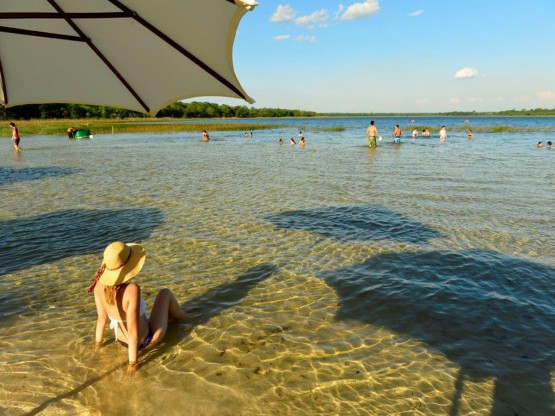
North Zone
Concepción
The capital of this Department is well-known for the beauty of its buildings and residences built at the beginning of the 20th century, when trade was flourishing and its port was a terminal of great fluvial activity. Currently, many vessels offer cruise and fishing services to sites located further north. The city counts with a good hotel infrastructure and with an excellent gastronomic service.
The downtown of the city of Concepción gathers many cultural institutions and centers. The museum of the Villa Real Barrack (Museo del Cuartel de Villarreal), the Civic Municipal and Historic Museum, the open-air museum on the Fernando de Pinedo Avenue and the Mansión Otaño museum are some places that can be easily visited due to the short distance that separates one from another. Temples, crafts and exhibitions complete the options box for the visitor.
Other districts of this Department are Belén, Horqueta, Loreto, San Lázaro, Yby Yau, San Carlos del Apa. In the last mentioned district, on the Apa River, it is possible to visit Fort San Carlos, built in 1794 to defend the territory from the raids of the Bandeirantes. There are sites of interest and attractions for the tourist in each of these mentioned districts.
San Pedro
The Department of San Pedro has more tan 150 Km of shore son the Paraguay River, and counts also with other important waterways such as the Ypane, Jejui, Aguaray Guazu, Manduvirä Rivers and many streams of good flow that help to create natural sites for recreation activities.
The capital of this Department is San Pedro del Ycuamandyyú, a city that preserves old buildings, colonial houses, historic places and legends that are part of its identity.
Another important city of this Department is San Estanislao, known in the popular jargon as Santaní. Its history dates back to the time of the Jesuits of the Mission of San Estanislao de Kostka. Santaní is currently an active trade center where agricultural producers of this Department meet.
18 further districts contribute with different resources to create conditions for the tourist to find in each of them the natural and cultural attractions to be enjoyed.
Amambay
This Department bordering with Brazil has the Amambay Mountains as the basic element in its physical formation. A line of mountains with an elevation of 300 to 400 meters is referred to as the “Terrace of Paraguay”.
The territory preserves the country´s richest forests, and a network of countless streamscross it in its entirety. Precisely, due to the abundance of water flows and because of the uneven ground, there are many waterfalls and cascades throughout the Department.
The fact that this is the place where the last war events took place (1865-1870), places this Department in a historic site where the Cerro Corá National Park is the place of utmost relevance. There you can visit the monuments to Mariscal López and to those who died with him in the last battle.
Amambay has not only natural resources, but there are also archeological resources in some hills near the city of. Very striking caves and rune inscriptions constitute research and care reasons. The Pai Tavytera native community, that has its tava in the zone, deems the set of hills as the “center of the universe” and home of the Supreme Lord.
Other districts of Amambay are Capitán Bado and Bella Vista, being the first one located south-east of the city of Pedro Juan Caballero and, the second one, north-west, on the Apa River shore. Both places feature highly attractive natural sites for adventure tourism.

South Zone
Itapúa
This Department that extends along the right bank of the Paraná River has, in the north area, a zone with highlands that are well-irrigated by little rivers and large creeks. Soils suitable for agriculture predominate in its central strip and further down south there are lands that are suitable for grazing.
Its capital is the city of Encarnación, currently under large-scale works due to the completion of the Yacyretá Dam. New Access roads, long bridges, refurbishment of shores, coastal avenues, new residential developments, building of an airport and other ventures that confer it a new urban look, however, without losing its identity forged by the process of incorporation of foreign communities that give a cosmopolitan stamp.
The Department of Itapúa is the trustee of three of the great Jesuit Missions that existed in Paraguay: Holy Trinity, Jesús of Tavarangué and San Cosme y San Damián. Holy Trinity offers the “Lights and Sounds” cultural tour; Jesús of Tavarangué offers its unfinished stunning structure; and San Cosme y San Damián offer the aggregate of its “Buenaventura Suarez” Astronomical Interpretation Center. The Missions of Trinity and Jesús were declared World Heritage by UNESCO in 1993.
Due to the quality and diversity of its inhabitants, due to the volume and variety of its production and due to its climate, this Department is known as the “melting pot” and as the “richest of Paraguay”. Communities of Germans, Ukrainians, Dutch, Belgians, Japanese, Brazilians, Slavs, Polish and immigrants of different backgrounds live in its districts, who fully integrated to the national way of life without losing theiroriginal cultural traits.
Itapúa has 30 municipal districts spread throughout “Graneros del Sur” Routes 1 and 6, or along the right bank of the Paraná River. They all count with high quality tourist services.
Misiones
Historically, it is reported as the core of the Jesuitical evangelization with its missions of San Ignacio Guazú, Santa Rosa, Santiago and Santa María. In these cities, it is possible to appreciate temples, museums, image collections and buildings of that time. The circuit is interconnected with a high quality road network and is supplemented with a good hotel and gastronomic service which extends to rural establishments.
The capital of this department is the city of San Juan Bautista, away 196 km from Asunción through Route No. 1. This city is an important agricultural and livestock production center and is the seat of official and cultural institutions.
Another important city is San Ignacio, which keeps in its Diocesan Museum beautiful art pieces of the Jesuitical time. The popular religiosity reaches its peak with the procession of the Holy Friday, which starts in the district of Tañarandy, and is accompanied with images, luminaires, groups of singers (“estacioneros”: those who pray frequently at the stations in church), thousands of worshippers, and which ends with the recreation, live, of famous pictorial or sculptural pictures inspired in the passion and death of Christ.
The highlights of Santiago are the missionary tradition, organized by the Lions Club and the Latin American Festival of Taming and Folklore (Tacuaty Ranch) which takes place every year in January and February.
The city of Ayolas is located on the banks of the Paraná River, which is close to the Yacyretá Hydroelectric Dam. Ayolas is famous for its fishing wells and for the commercial movement generated by the hydroelectric dam itself. It counts with a good hotel infrastructure.
Ñeembucú
Located in the vertex formed by the confluence of the Rivers Paraná and Paraguay, the Ñeembucu department is the only one that has shores on these two big water courses.
The territory is characterized by its sedimentary soil, floodable plains and permanent wetlands. Beautiful nature is shown in all its extension and it’s also a showcase of historical places.
Pilar is the main city of Ñeembucú. Among its attractions, this city keeps the Town Hall building, big old houses, the minor Basilica of the Virgin of Pilar, streets and avenues ornamented with foliage and sculptures. Every year, Pilar hosts an important art festival where ballet casts, bands and theatre groups from different cities of the region perform.
The Triple Aliance War left its most visible scar in the city of Humaitá. The ruins of the San Carlos Borromeo temple lay there; as well as the Battery of London, which once was Mariscal López guardhouse. Also, the remains of battle trenches, pieces of guns, and munitions are conserved in museums.
Isla Umbú is another district of Ñeembucú that has history to tell and heritage to exhibit. Its church, images, old headquarters, military museums and antique constructions are part of the attractions that can be found there.
The variety of attractions of the Ñeembucú department depends of its luxuriant nature in the tours along its fields and wetlands as well as the sail of its rivers. Moments of pleasure await the tourists with the fishing and riverside walks. People interested in reviewing historical episode, count on the ruins, sunken ships, museums, monuments, old battle fields and camps.

Central Zone
Guairá
It is a small department even though it holds 17 municipal districts. Its capital is called Villarrica, 173 km away from Asunción. This city shows typical features that can be noticed by the special accent and the cultural traditions that brighten its crests. Villarrica gets very crowded in February every year for the carnival party. The festival of the race is celebrated in October and May is the month of their founding anniversary, so big celebrations take place in that month. It has good hotels and other services for tourists.
Cratfs has its center in the Yataity district. All the population there focuses on threading and “ao po’i” fabric production. Embroidered shirts, clothes for women, table linen and other fabrics daintily made in rustic looms and hand embroidered that are all over the national market and penetrates the international business and fashion centers. Every September the Ao Po’i fair is celebrated and has a very big cultural and commercial impact.
Nearby Villarrica, relieves can be seen in a big wall, made by visitors or passersby that wanted to leave a message for posterity and that could not be decoded until our days.
Caaguazú
Its name represents the apocope of Caaguy Guazú (Big forest), because it used to be a zone of large forest extensions. Up until these days, this department and one of its cities are identified as the capital of wood. Its main natural attractions are in the Guayaki Park, the Yguazu Lake and the mountainous region of Saint Joaquin.
The capital of the Caaguazu Department is the city of Coronel Oviedo, located 132 km away from Asunción. Route 2 gets until there and from that point, route 7 goes east, route 3 goes north and route 8 goes south.
This allows an easy access to other cities like Concepción and Pedro Juan Caballero by going north; Villarrica and Caazapá by going south and Ciudad del Este, Hernandarias and others by going east. The Yguazú Lake is currently one of the resources that is planned to use as a series of touristic attractions.
The Caaguazú department holds 21 municipal districts. Coronel Oviedo is the one that has the bigger population and a better touristic infrastructure, followed by Caaguazú and San José de los Arroyos.
Caazapá
This department´s and its capital´s name suggest the existence of legends and magical powers that blossomed in the beginning of its existence and during the evangelization by the Franciscan in the colonies.
The creation of the spring called Ykua Bolaños (spring or fountain Bolaños) is attributed to a miraculous act performed by a priest; this act appeased the chief that was anxiously and furiously looking for water for his tribe and himself.
With a pontifical gesture, Fray Luis of Bolaños made water sprout from the rocks, and with that, he also made afflictions caused by the drought vanish. Since then, anyone who drinks this water finds themselves trapped by a spell that will link them forever with Caazapá.
The city of Caazapá distinguishes by its cultural and historical patrimony forged by the Franciscans. Its church in honor to Saint Pablo keeps altarpieces and carved wood images. The Chapel of Saint Roque that is a building that dates from the XVII century and the houses that conserve the colonial style and popular traditions, that remain in force confer the city and its people a special appeal.
The industrial and artisanal fair, and the Ykua Bolaños Festival that take place every January in the city of Caazapá, complete the best picture for local and foreign tourist to find this as a point of interest.
A city that is winning spaces in the developing area, is the city zone of San Juan Nepomunceno. A great part of the farming production concentrates in the zone; its area of influence reaches other communities and has offers to satisfy the inside touristic demand.



